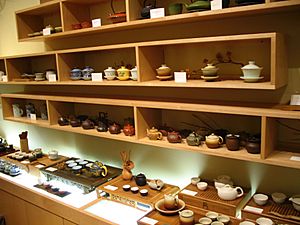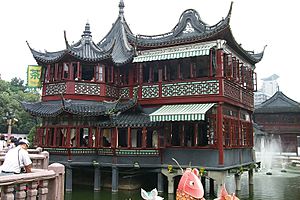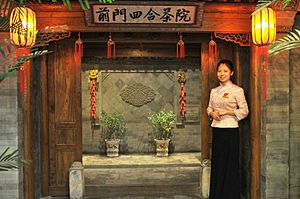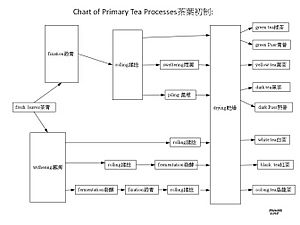Chinese tea facts for kids

|
|
| Type | Tea |
|---|---|
| Country of origin | China |
| Region of origin | East Asia |
| Colour | Green |
| Ingredients | Tea leaves |
| Related products | Tea |
| Chinese tea | |||||||||||||||||||||
|---|---|---|---|---|---|---|---|---|---|---|---|---|---|---|---|---|---|---|---|---|---|
| Traditional Chinese | 茶 | ||||||||||||||||||||
| Simplified Chinese | 茶 | ||||||||||||||||||||
| Literal meaning | Tea | ||||||||||||||||||||
|
|||||||||||||||||||||
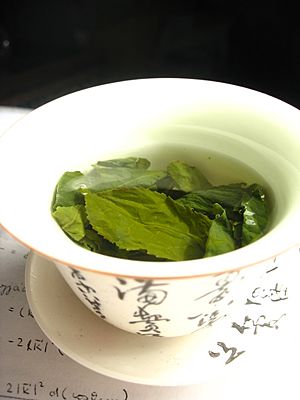
Tea is a popular drink made from the leaves of special tea plants, called Camellia sinensis. These leaves are prepared using old Chinese methods. Chinese tea is enjoyed all day long in China. People drink it with meals, instead of water, for their health, or just for fun!
Contents
History of Chinese Tea
The story of drinking tea began in China a very long time ago. Legend says that Chinese Emperor Shen Nong discovered tea in 2737 BC. A tea leaf fell into his boiling water, and he liked the taste! Tea is a big part of China's history and culture. It's even called one of the "seven necessities" of Chinese life, along with things like rice and salt.
Types of Chinese Tea
Chinese tea comes in six main types: white, green, yellow, oolong, black, and post-fermented (also called dark tea). All these teas come from the same Camellia sinensis plant. The difference is how they are processed.
Most Chinese teas are grown and enjoyed in China. But now, they are also sent to other countries because Chinese food is popular worldwide. Green tea is the most common type of tea drunk in China.
There are hundreds of different kinds of Chinese teas! Some differences come from the type of tea plant. The best places for growing tea are Yunan and Fujian provinces. But the biggest reason for so many kinds of tea is how the leaves are prepared after they are picked.
- White and Green Teas: These are heated soon after picking. This stops them from changing color and flavor, a process called oxidation.
- Oolong Teas: These are partly oxidized. This means they are allowed to change a little bit.
- Black Teas: These are fully oxidized. This gives them their dark color and strong flavor.
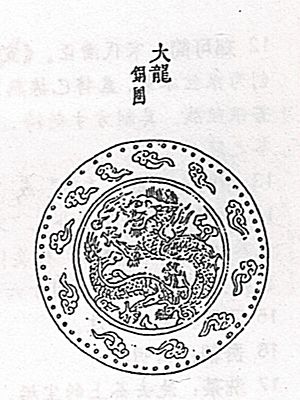
Tea in the Song Dynasty
Tea was very important during the Song Dynasty. Tea farms were found in many areas. Expensive "tribute tea" from Zhejiang and Fujian provinces was even sent to countries in Southeast Asia and the Arab world.
During the Song Dynasty, tea started to be pressed into tea cakes. Some of these cakes had beautiful patterns of Chinese dragons and phoenixes. They had fancy names like "Large Dragon tea cake" and "Eternal Spring Jade Leaf."
Tea in the Ming Dynasty
A famous scholar named Wen Zhenheng wrote about different teas in his book Zhǎng Wù Zhì.
Famous Ming Dynasty Teas
- Huqiu Tea: This tea was thought to be the best in the world, but not much was made.
- Tianchi Tea: Some people thought this tea tasted even better than Huqiu tea.
- Jie Tea: From Changxing County, this tea was highly valued by tea experts, but it was quite expensive.
- Lu'an Tea: Also called Lu'an Melon Seed tea, this tea was used in Chinese medicine. It was known for its good quality and was helpful for people with stomach problems. The best Lu'an tea came from a cave where bats helped fertilize the plants!
- Songluo Tea: This tea was made on Songluo Mountain in Anhui Province. It was very special, and only a few families knew how to prepare it perfectly.
- Longjing and Tianmu Tea: These teas were compared to Heaven Pool tea. They grew in cold, snowy mountains, which made their leaves sprout later. Longjing tea is from Hangzhou, and Tianmu tea is from Tianmu Mountain.
Tea as a Special Payment
During the Ming Dynasty, tea was used as a kind of money. It was also given as a special payment, or "tribute," to the emperor. The first Ming emperor, Zhu Yuanzhang, came from a poor family. He understood how hard farmers worked. So, he changed the rule. Instead of making farmers press tea into bricks, he said they could pay tribute with loose tea leaves. This made life much easier for tea farmers! Making tea bricks was a very long and difficult process.
Tea in Ming Literature
Writers and artists during this time often focused on tea picking. They wrote poems and created art about how tea was picked and processed.
Here's a poem about tea picking by Gao Qi: It is getting warm after the spring rain and thunder, New tea leaves start sprouting among branches. Girls with silver hairpins sing folk songs to each other, Competing to pick the most tea leaves in the shortest time. They get home with the fresh scent of tea leaves on their hands, The highest qualities will be sent to the Prefecture first. The newly baked tea leaves are not tasted yet, They are packed into baskets and will be sold to Hunan merchants.
Some poems also showed the struggles of tea farmers and made fun of greedy officials. As time went on, officials demanded more and more tribute tea. This made many people, including poets like Gao Qi and Han Bangqi, very angry. They wrote poems asking for less taxes and tributes. Sadly, Gao Qi faced serious trouble for speaking out, and Han Bangqi was put in prison.
Tea Farmers
Most tea farms were small family businesses. But there were also tea merchants who owned bigger tea plantations. These merchants often hired seasonal workers during harvest time. These workers would travel to places like Tunxi, Anhui, where lots of tea leaves grew.
How Tea Was Made
Making tea depended a lot on the weather. So, tea couldn't be made all year round. Certain areas like Jiangnan and Hunan were perfect for growing tea because they had warm weather and enough rain.
The main steps for making loose-leaf teas were: planting tea seedlings, caring for the plants, picking the leaves, sunning/firing/rolling them, and then sorting and packaging.
Picking Tea Leaves
Picking tea leaves was a very important step. The best time to pick tea leaves was early in the morning before the sun came up. Tea pickers had to be careful to pick the whole leaves gently. They would use their fingers and thumbs to nip the green stems. Women were often preferred for this job because they were thought to be more gentle and careful. Old beliefs meant that at certain times, women were not allowed to help with tea making.
Sunning, Firing, and Rolling
After picking, the damaged leaves were removed. Then, the leaves were "sunned" to help them dry a bit and start to oxidize. Too much oxidation can make the tea taste bitter. So, farmers would heat the leaves to stop the oxidation when it was just right. This was called "firing."
Next, the leaves were gently rubbed to break open their cells. This helped release their smells and flavors when brewed. The tea leaves were then rolled into shapes. This made them easier to store and helped squeeze out more flavor.
Sorting and Packaging
Once the leaves were dry again, they were sorted and packaged. Tea was often carried by porters using poles to transport chests of tea to merchants. Much of the tea was sold to merchants and exported to other places.
Tea Culture
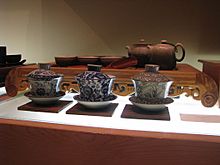
Tea Customs and Manners
In some Chinese restaurants, people often clean their bowls and utensils at the table. They rinse them with tea from the pot. A larger bowl might be given to collect the used tea. In restaurants, tea is often served instead of water.
For daily drinking, many Chinese people use a special personal tea bottle. They put tea leaves in it and let them steep for hours, sipping the tea throughout the day. This means they use the same tea leaves many times.
Tea Tools
A traditional Chinese tea set has special clay or porcelain teapots, teacups, and other tools. These include tea spoons, strainers, draining trays, and special tongs for leaves and cups. All these tools are kept on a wooden tea tray that can drain water. Nowadays, some Chinese people even use electric hotplates for their tea sets.
Tea Places
Tea Garden
A tea garden is a place with a beautiful Chinese garden where people can relax and enjoy their tea.
Tea House
Chinese tea houses are public places where people gather to drink tea and spend time. They have a long history, starting in the Tang Dynasty and becoming very common in the Song Dynasty. By the Ming and Qing dynasties, tea houses were a big part of local culture.
Many people go to tea houses in the morning to relax, have fun, and share news. You might see older people sharing stories or young people talking about their dreams.
In the 1970s, Chinese tea houses became popular in Hong Kong. Business people would use them to meet and make deals. For example, a jade merchant might finish a sale in a tea house.
Sichuan Teahouses
Sichuan teahouses come in all sizes. Some are huge with hundreds of seats, while others are small. They are known for great service. Traditional Sichuan teahouses use special teapots and cups. They also have "tearoom keepers" who are experts at everything tea-related. Sichuan teahouses are also important for sharing news and even act like unofficial courts!
Hangzhou Teahouses
The Wu-Yue area is famous for growing tea, especially green tea from Zhejiang province. In Hangzhou, most teahouses are simple and elegant. They focus on making tea with good water and enjoying tea in a peaceful setting. This helps people truly appreciate the art of tea.
Tianjin, Shanghai, and Guangdong Teahouses
- Tianjin Teahouses: These teahouses often serve business people. People drink tea, eat snacks, and enjoy performances like singing or storytelling.
- Shanghai Fuchaguan Teahouses: In the past, Shanghai teahouses were seen as fancy and refined places. People called them "fuchaguan" to show their desire for leisure. The most famous ones were in the old Chenghuangmiao area.
- Guangdong Tearooms: Old Guangdong tearooms were cheap. Customers would get a cup of tea and a few steamed buns or dumplings. Today, they offer a pot of strong tea and many different snacks from a food cart.
Beijing Teahouse Culture
Beijing teahouses combine the best features of other regional teahouses. They are known for their many uses and rich cultural meaning.
There are different kinds of Beijing teahouses:
- Shuchaguan: Here, people mainly came to listen to storytelling. Tea was just a side drink. Storytelling could last for months! These places were decorated to create a good atmosphere for stories. People came to learn history, pass time, and have fun.
- Qingchaguan: These were simple places for people to relax. They served tea in cups with covers, but no snacks.
- Qichaguan: These teahouses were for playing chess. They had simple tables or boards painted with chess games. People would play chess while drinking tea, often forgetting their worries. That's why tea was sometimes called "Mr. Worry-free."
- Yechaguan: People went here to enjoy beautiful gardens. These teahouses were built in places with nice views and gardens, as Beijing people loved to enjoy nature in different seasons.
- Dachaguan: These offered tea, food, and services to business people and scholars.
- Hongluguan: Had red stoves that baked delicious pastries. Customers could drink tea and try these small, fancy pastries.
- Wowoguan: Served various snacks like steamed sponge cakes and sesame seed cakes.
- Banhuguan: Had a large copper pot and offered many different tastes.
- Erhunpu: These served tea but also had dining and wine. They provided food cooked from their own ingredients or from ingredients customers brought.
Literature
Famous Chinese Teas
The "Ten Great Chinese Teas" are the most well-known Chinese teas. Here is a list of some common teas in China:
| Chinese | English | Region | Type |
|---|---|---|---|
| 西湖龙井 | Longjing tea (Dragonwell) | Hangzhou, Zhejiang | Green tea |
| 洞庭碧螺春 | Biluochun tea (Green snail spring) | Suzhou, Jiangsu | Green tea |
| 安溪铁观音 | Anxi Tieguanyin tea | Anxi, Quanzhou, Fujian | Oolong tea |
| 黄山毛峰 | Huangshan Maofeng tea | Huangshan, Anhui | Green tea |
| 武夷岩茶-大红袍 | Wuyi tea, e.g., Da hong pao (Big red robe) | Wuyi Mountains, Fujian | Oolong tea |
| 君山银针 | Junshan Yinzhen (Jun Mountain silver needle) | Yueyang, Hunan | Yellow tea |
| 祁门红茶 | Keemun Black tea | Qimen, Huangshan, Anhui | Black tea |
| 六安瓜片 | Lu'an Melon Seed tea | Jinzhai, Lu'an, Anhui | Green tea |
| 云南普洱 | Yunnan Pu'er | Pu'er City, Yunnan | Post-fermented tea or "dark" tea |
| 白毫银针 | Baihao Yinzhen (White tip silver needle) | Fuding, Ningde, Fujian | White tea |
Tea Production and Trade
How Tea is Produced
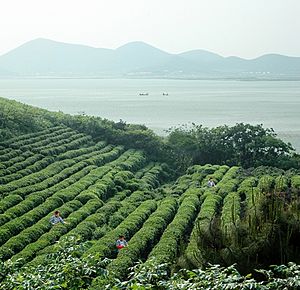
The best white, yellow, and green teas are made from young tea shoots picked in early spring. These shoots might be just a single bud or a bud with a few small leaves.
Teas that are more oxidized, like black or oolong tea, are made from older, more mature leaves. For example, Anxi Tieguanyin tea uses one bud with two to four leaves.
Not all high-quality green tea uses only young shoots. The famous Lu'an Melon Seed tea is made from more mature leaves.
Traditionally, these young tea shoots are picked before April 5th, around the Qingming Festival. Tea picking usually starts when about 5% of the tea garden is ready. In some gardens, tea shoots are picked every day or every two days.
Tea Trade
Before the 1980s, European countries imported a lot of Chinese tea through trade missions in Shanghai. This helped increase China's tea exports.
However, since the mid-1990s, China's tea exports have grown more slowly. This is partly because of new rules about tea safety and pesticide limits in other countries. Even though China exports a lot of green tea, its share of the global market has sometimes gone down. But in 2010, China still provided 79% of all green tea exported worldwide.
Different Kinds of Tea
The names of tea varieties often use older English spellings or southern Chinese pronunciations, not always modern pinyin.
See also
 In Spanish: Té de China para niños
In Spanish: Té de China para niños


